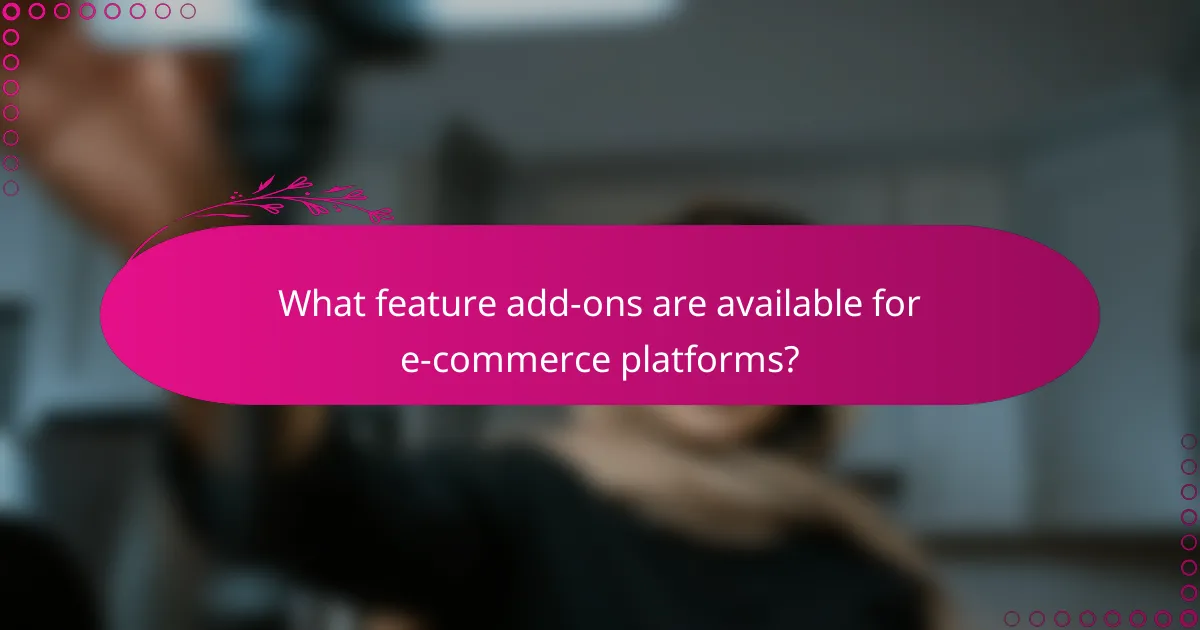E-commerce platforms in Canada present a range of transaction fees, typically between 1% to 3% per transaction, influenced by the chosen provider and plan. Monthly subscription costs can vary widely, from modest amounts to several hundreds of USD, depending on the features and services selected. Additionally, businesses can enhance their online stores with various feature add-ons, such as payment processing tools and marketing integrations, allowing for greater customization and improved user experience.

What are the transaction fees for e-commerce platforms in Canada?
Transaction fees for e-commerce platforms in Canada vary significantly based on the provider and the specific plan chosen. Typically, these fees can range from around 1% to 3% per transaction, with additional monthly subscription costs and optional feature add-ons that may influence overall expenses.
Shopify transaction fees
Shopify charges transaction fees that depend on the pricing plan selected. For example, the Basic plan incurs a fee of 2.9% + 30¢ per transaction for online credit card rates, while the Advanced plan reduces this to 2.4% + 30¢. Merchants can avoid these fees entirely by using Shopify Payments, their integrated payment processor.
Additionally, Shopify offers various subscription tiers, each with its own features and pricing. Businesses should evaluate their sales volume and payment processing needs to choose the most cost-effective plan.
BigCommerce transaction fees
BigCommerce does not charge transaction fees on any of its plans, which can be advantageous for high-volume sellers. Instead, the platform offers tiered pricing based on annual sales, with plans starting from around CAD 39 per month for lower sales volumes and increasing for higher tiers.
Merchants using third-party payment gateways may still incur fees from those providers, so it’s essential to factor this into the overall cost structure. BigCommerce’s lack of transaction fees can lead to significant savings for businesses with large sales volumes.
WooCommerce transaction fees
WooCommerce itself is a free plugin for WordPress, but transaction fees depend on the payment gateways chosen. Popular options like PayPal and Stripe typically charge around 2.9% + 30¢ per transaction, similar to Shopify. However, WooCommerce allows for extensive customization, which can lead to varying costs based on the features and extensions used.
Merchants should consider the total cost of ownership, including hosting fees and any premium extensions, when using WooCommerce. It’s advisable to compare payment processors to find the most cost-effective solution for your business needs.

What are the monthly subscription costs for e-commerce platforms?
The monthly subscription costs for e-commerce platforms vary significantly based on features, scalability, and support. Typically, these costs range from low tens to several hundreds of USD, depending on the plan and additional services chosen.
Shopify monthly plans
Shopify offers several pricing tiers, starting from around $39 per month for the Basic plan, which includes essential features for small businesses. The Shopify plan, priced at approximately $105 per month, adds more advanced reporting and professional reports, while the Advanced plan at about $399 per month caters to larger businesses with extensive needs.
When selecting a plan, consider transaction fees, which can vary based on your payment processing choice. Shopify Payments has no additional fees, but using third-party gateways incurs a fee that can be a percentage of sales.
BigCommerce monthly plans
BigCommerce provides a range of plans starting at about $39 per month for the Standard plan, which is suitable for startups. The Plus plan, around $105 per month, includes features like customer segmentation and abandoned cart recovery, while the Pro plan, priced at approximately $399 per month, is designed for larger enterprises with advanced needs.
BigCommerce does not charge transaction fees on any of its plans, which can be a significant advantage for businesses with high sales volumes. However, it’s essential to evaluate the annual sales threshold for each plan to ensure you select the right one for your business growth.
Wix eCommerce pricing
Wix offers eCommerce plans starting from around $27 per month for the Business Basic plan, which includes online payments and a free domain for one year. The Business Unlimited plan, priced at approximately $32 per month, provides additional features like subscriptions and automated sales tax.
Wix’s pricing structure is straightforward, with no transaction fees on any of its plans. This can be beneficial for small to medium-sized businesses looking to minimize costs while still accessing essential eCommerce functionalities.

What feature add-ons are available for e-commerce platforms?
E-commerce platforms offer a variety of feature add-ons that enhance functionality and improve user experience. These add-ons can range from payment processing tools to marketing integrations, allowing businesses to customize their online stores according to specific needs.
Shopify feature add-ons
Shopify provides a robust app store with thousands of feature add-ons that cater to various business requirements. Popular categories include inventory management, customer support, and marketing tools. For instance, apps like Oberlo help with dropshipping, while Klaviyo focuses on email marketing automation.
When selecting add-ons, consider the associated costs, as many apps charge monthly fees or take a percentage of sales. It’s essential to evaluate which features will provide the best return on investment for your specific business model.
BigCommerce feature add-ons
BigCommerce offers a range of add-ons that can enhance the platform’s capabilities, particularly in areas like SEO and analytics. Integrations with tools such as Google Analytics and Mailchimp allow for better tracking and customer engagement. Additionally, BigCommerce supports various payment gateways, making it easier to manage transactions.
Before committing to any add-ons, assess their compatibility with your existing setup and how they align with your business goals. Some add-ons may require technical expertise to implement effectively.
WooCommerce plugins
WooCommerce, as a WordPress plugin, has a vast library of plugins that extend its functionality. These plugins cover everything from payment gateways to shipping solutions, allowing for a highly customizable e-commerce experience. Popular options include WooCommerce Subscriptions for recurring payments and WooCommerce Bookings for service-based businesses.
When choosing plugins, prioritize those that are regularly updated and have positive user reviews. Be mindful of potential conflicts between plugins, which can affect site performance and user experience.

How do transaction fees impact overall costs?
Transaction fees significantly affect the overall costs of using an e-commerce platform. These fees can vary widely between platforms and can influence your profit margins, especially for businesses with high sales volumes.
Cost comparison of platforms
When comparing e-commerce platforms, it’s essential to evaluate their transaction fees alongside monthly subscriptions and additional costs. Some platforms charge a flat fee per transaction, while others may take a percentage of each sale. For example, a platform might charge 2.9% plus $0.30 per transaction, which can add up quickly for high-ticket items.
Additionally, consider whether the platform offers a tiered pricing model based on sales volume. This can lead to lower fees for businesses that scale up their operations. Always calculate the total cost of ownership, including transaction fees, to make an informed decision.
Long-term financial implications
Understanding the long-term financial implications of transaction fees is crucial for sustainable growth. High transaction fees can erode profit margins over time, particularly for businesses with tight margins or high transaction volumes. For instance, if your monthly sales are $10,000 and you pay 3% in fees, that’s $300 lost each month.
To mitigate these costs, consider negotiating fees with your payment processor or exploring platforms that offer lower rates. Additionally, factor in how these fees will impact your pricing strategy and overall financial planning. Regularly review your transaction costs to ensure they align with your business goals.

What should you consider when choosing an e-commerce platform?
When selecting an e-commerce platform, consider transaction fees, monthly subscriptions, and available feature add-ons. These factors significantly impact your overall costs and the platform’s ability to meet your business needs.
Key features to evaluate
Evaluate essential features such as payment processing, inventory management, and customer support. Look for platforms that offer a user-friendly interface, mobile responsiveness, and customizable templates to enhance your online store’s functionality.
Consider the scalability of the platform as your business grows. A good e-commerce solution should support increased traffic and sales without compromising performance. Check for features like analytics tools and marketing integrations that can help you optimize your business strategy.
Integration capabilities
Integration capabilities are crucial for ensuring your e-commerce platform works seamlessly with other tools you use, such as accounting software, CRM systems, and shipping services. Look for platforms that offer a wide range of integrations to streamline your operations.
Check if the platform supports APIs or third-party plugins, which can enhance functionality without requiring extensive coding. For example, platforms like Shopify and WooCommerce provide numerous integration options that can cater to various business needs.

What are the emerging trends in e-commerce platforms?
Emerging trends in e-commerce platforms focus on adapting to consumer preferences and technological advancements. Key areas include subscription model shifts, transaction fee structures, and the integration of feature add-ons to enhance user experience.
Subscription model shifts
Subscription models in e-commerce are evolving to offer more flexibility and value to consumers. Businesses are increasingly adopting tiered subscription plans that cater to different customer needs, allowing users to choose based on their purchasing habits and budget.
For example, platforms may offer basic, premium, and enterprise tiers, with varying features such as transaction limits, customer support levels, and access to exclusive products. This approach can help businesses retain customers while maximizing revenue.
When considering subscription models, it’s crucial to analyze customer feedback and market trends. Regularly updating offerings based on user preferences can lead to higher satisfaction and lower churn rates.
